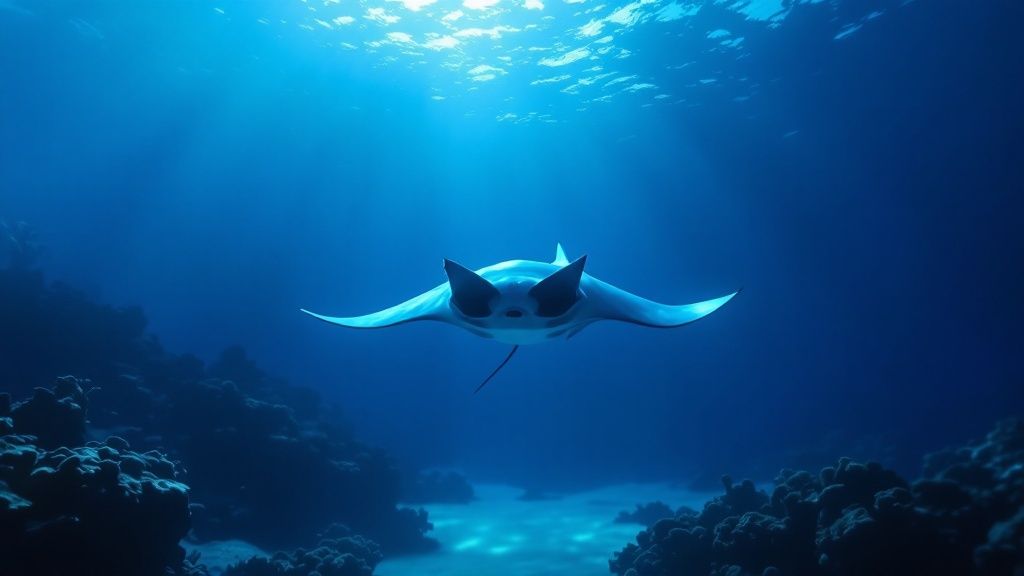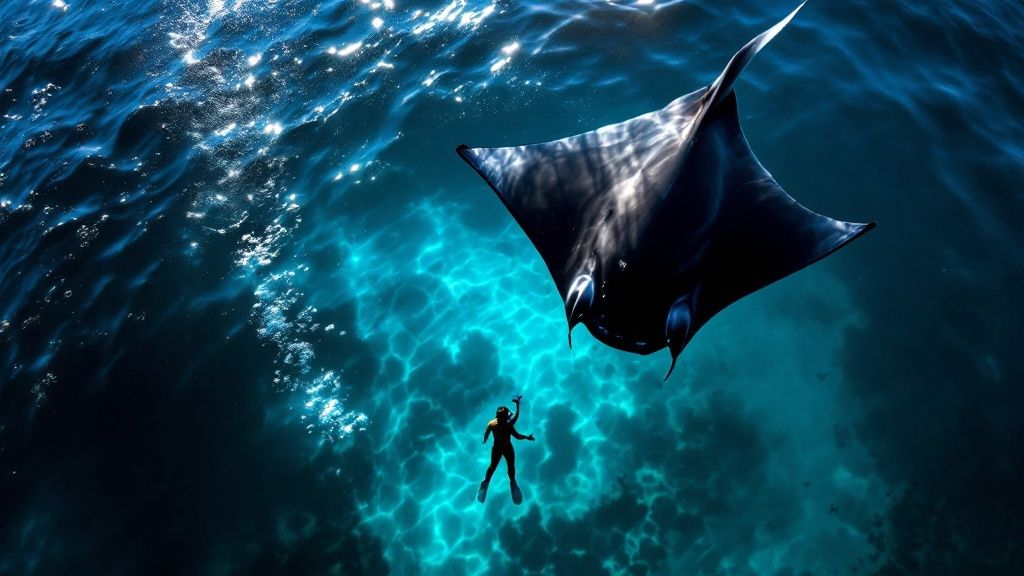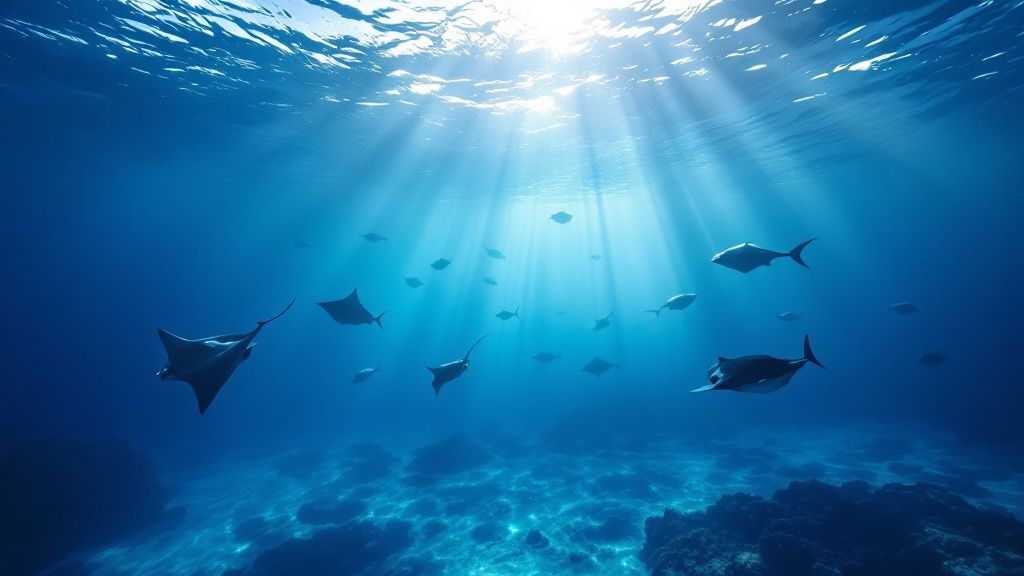Why Kona Is the Manta Ray Capital of the World

The Kona Coast of Hawaii isn't just another pretty island destination. It's earned a global reputation as the "Manta Ray Capital of the World." But what sets this area apart and draws these gentle giants? It's a special mix of environmental factors that create the perfect habitat.
Kona's Perfect Recipe for Manta Rays
The underwater landscape of Kona plays a crucial role. Volcanic slopes have formed deep channels and protected bays. These serve as both feeding grounds and resting areas for the mantas. The waters around the island are also rich in nutrients, which support a large plankton population. Plankton, of course, is the manta ray's main food source.
This abundance of food is a major draw. The shallow, protected bays provide particularly calm waters, especially important for the mantas' nighttime feeding habits. Kona’s clear waters also offer superb visibility, especially beneficial for manta ray Kona snorkel tours.
This clarity, combined with the calm ocean conditions, creates incredible viewing opportunities. Clear water, calm seas, and plenty of food: it's an ideal scenario for both the mantas and the people who want to snorkel alongside them.
The Nighttime Spectacle: A Feast for the Senses
Manta rays are mostly nocturnal feeders, and Kona's nighttime manta ray snorkel tours are famous. Tour operators use special lights that attract plankton, creating a concentrated "plankton soup." This brings the mantas close to the surface, providing snorkelers with up-close encounters. Learn more about Manta Ray Night Snorkel excursions here.
The Kona Coast is known for its consistent manta ray sightings, particularly on night snorkeling trips. Researchers meticulously tracked over 250 individual manta rays between 2009 and 2014 at sites like "Manta Village" and "Manta Heaven." They found that many individuals returned to the same feeding locations, demonstrating the reliability of Kona's rich food sources, further amplified by the tour lights. This underscores Kona's status as a prime location for seeing these creatures in the wild. Find more detailed statistics here.
To help illustrate the frequency of sightings at various locations, take a look at the table below:
Manta Ray Sighting Statistics in Kona
A breakdown of manta ray sightings at popular Kona snorkeling locations
| Location | Sighting Success Rate | Best Time | Average Number of Mantas |
|---|---|---|---|
| Manta Village | 95% | Night | 10-15 |
| Manta Heaven | 90% | Night | 5-10 |
| Garden Eel Cove | 75% | Day | 2-5 |
| Keauhou Bay | 60% | Day & Night | 1-3 |
This data highlights the remarkable consistency of manta ray sightings, especially at Manta Village and Manta Heaven during nighttime excursions. The success rates underscore Kona's reputation as a manta ray hotspot.
A Commitment to Sustainable Tourism
Several reputable tour operators in Kona prioritize both visitor satisfaction and manta ray conservation. They offer manta ray Kona snorkel experiences with a focus on sustainability. Explore various Kona Snorkel Trips. Discover more with Captain Cook Snorkeling Tours. For example, Kona Honu Divers is committed to sustainable practices, working alongside researchers and conservationists. Learn more about manta ray snorkel tours with Kona Honu Divers. This dedication to responsible tourism ensures minimal impact on the manta rays and their environment, safeguarding these gentle giants for future generations. This thoughtful approach not only protects the mantas but also deepens the experience for snorkelers, fostering a greater respect for these magnificent creatures.
The Magic of Your Manta Ray Kona Snorkel Experience

The excitement begins the moment you board the boat for your manta ray Kona snorkel adventure. A short ride takes you to a designated manta viewing area, such as Manta Village or Manta Heaven. These locations are known for their calm waters and frequent manta ray sightings. As the sun sets, the guides prepare specialized lighting, setting the stage for an unforgettable experience.
Illuminating the Ocean: The Manta Ray Buffet
These lights play a vital role, attracting plankton, the manta ray's main food source. This creates a "plankton soup," an irresistible feast for these gentle giants. Snorkelers then have the incredible opportunity to witness the mantas' feeding behaviors up close, in their natural environment. Drawn by the light and the abundance of food, the mantas perform graceful underwater ballets just below the surface.
It's a truly awe-inspiring spectacle. Imagine massive manta rays, with wingspans of up to 10 feet, gliding effortlessly beneath you. Their movements are mesmerizing, a perfect blend of power and grace. Many snorkelers describe a deep connection with these creatures, a sense of wonder that lingers long after leaving the water.
Ensuring Safety and Respect For Wildlife
Tour operators prioritize both your safety and the well-being of the manta rays. Guides provide thorough briefings on responsible interaction with these magnificent animals. Snorkelers are instructed to avoid touching the mantas, as their sensitive skin is covered in a protective mucus layer vital to their health.
For a deeper dive into this, check out How to master the manta ray night snorkel on the Big Island. Guides will also equip you with flotation devices and explain proper snorkeling techniques. This ensures you can comfortably observe the mantas without disrupting their natural behavior. Reputable operators like Kona Honu Divers and Kona Manta Dive adhere to strict guidelines for minimal environmental impact, promoting sustainable manta ray tourism. This protects the mantas and enriches the experience for snorkelers, fostering greater appreciation for these incredible creatures.
To help you choose the perfect tour, here's a comparison of some top-rated operators:
Manta Ray Kona Snorkel Tour Comparison:
| Tour Company | Price Range | Group Size | Duration | Amenities | Special Features |
|---|---|---|---|---|---|
| Kona Honu Divers | $150-$200 | 6-12 | 2-3 hours | Flotation devices, wetsuits, snacks, drinks | Small group sizes, personalized attention |
| Kona Manta Dive | $125-$175 | 10-20 | 2-3 hours | Flotation devices, wetsuits, hot chocolate | Underwater photography available |
| Big Island Divers | $140-$190 | 8-16 | 2-3 hours | Flotation devices, wetsuits, snacks | Certified marine naturalist guides |
| Fair Wind Cruises | $160-$210 | 20-30 | 3-4 hours | Flotation devices, wetsuits, dinner, drinks | Large boat with ample space, sunset views |
| Sea Paradise | $130-$180 | 12-24 | 2-3 hours | Flotation devices, wetsuits, snacks | Focus on education and conservation |
This table provides a quick overview of various tour options, highlighting differences in group size, price, and included amenities. Researching different companies can help you find the experience that best suits your needs and preferences.
Beyond the Snorkel: An Unforgettable Memory
The manta ray Kona snorkel is more than just an activity; it's a powerful connection with nature. The close encounter with these gentle giants, combined with the unique nighttime setting, creates a lasting memory. From the boat ride to the final goodbyes, every moment is part of the magic. Whether you're a seasoned snorkeler or trying it for the first time, this is an adventure you won't forget. Learn more about Manta Ray Snorkel tours in Kona. Explore Captain Cook Snorkeling Tours for other options.
Choosing Your Perfect Manta Ray Kona Snorkel Adventure

Kona, a prime location for manta ray sightings, offers a plethora of snorkel tour options. With so many choices, finding the perfect tour can feel daunting. Thorough research is essential for an unforgettable experience. Let's explore the key factors to consider when planning your manta ray Kona snorkel adventure.
Tour Operators: A Diverse Landscape
Kona has a wide range of tour operators, each with its own distinct approach. Kona Honu Divers specializes in small groups and personalized service. Manta Ray Night Snorkel Hawaii emphasizes intimate encounters with the majestic creatures.
For a broader perspective and comparison of various operators, check out Kona Snorkel Trips. They offer overviews, including insights into companies like Captain Cook Snorkeling Tours. This allows you to select a tour tailored to your specific desires.
Key Considerations: Beyond the Basics
While planning your manta ray adventure, remember Kona offers a variety of other activities. You might even consider exploring options like fun activities in Las Vegas without drinking. Back in Kona, beyond simply choosing an operator, several factors significantly influence your overall snorkel experience.
Consider the group size: smaller groups often mean more individual attention from the guides. Tour duration also varies, from shorter excursions to longer trips incorporating additional activities. Amenities, such as provided equipment, snacks, and refreshments, further contribute to your comfort and enjoyment.
Manta ray snorkeling in Kona draws approximately 80,000 visitors annually, highlighting its popularity as an ecotourism activity. Tour operators boast an impressive 85-90% success rate for manta ray sightings on night snorkel trips. These tours employ specialized underwater lights that attract plankton, mimicking the mantas’ natural feeding environment. This creates incredible close-up encounters and unique viewing opportunities. For more detailed information, explore manta ray sighting statistics.
Matching Your Needs to the Right Tour
Are you a family with children? A solo adventurer? Or perhaps a photography enthusiast? Defining your specific needs is paramount. You may find articles like What it’s like to go on a manta ray dive helpful. Some tours cater specifically to families, while others are designed for solo travelers or those seeking educational experiences. If you're interested in underwater photography, inquire about specific opportunities and any potential restrictions.
By addressing these aspects, you can select the manta ray Kona snorkel tour that truly aligns with your expectations, ultimately creating a truly memorable adventure.
Insider Tips for an Extraordinary Manta Ray Kona Snorkel

While selecting the right tour operator is key, your preparation for the manta ray Kona snorkel itself can greatly elevate the entire experience. These insider tips will ensure you have a fantastic time and make lasting memories.
Timing is Everything: Moon Phases and Water Conditions
Plankton visibility is affected by the moon’s brightness, which directly impacts manta ray activity. Darker nights, particularly during a new or crescent moon, often lead to more spectacular manta ray sightings. This is because the plankton becomes more concentrated around the tour boat lights. Calm water also generally means improved visibility. Check the local marine forecast before heading out, and consider rescheduling if the water looks choppy. For further reading on the best time to see these amazing creatures, check out our article about the best time of year to see manta rays in Kona.
Positioning for the Perfect View
Once you’re in the water, position yourself near the light source, but do so calmly. Avoid splashing or sudden movements that could frighten the manta rays. Let the mantas approach you. These gentle giants are curious by nature and often swim incredibly close to snorkelers.
Staying Calm and Fog-Free
It's thrilling to see these majestic creatures up close, but staying relaxed is key to the best possible viewing experience. Deep breaths help regulate your body and maintain buoyancy. Here's a pro tip for a fog-free mask: baby shampoo. Rub a small drop inside your mask, spread it around, and give it a light rinse. This trick creates a thin film that prevents fogging, giving you a crystal-clear view.
What to Wear and Bring
Kona evenings can get surprisingly chilly on the water. A wetsuit is usually a good idea, although some tour operators provide them. Dressing in layers helps you adapt to changing temperatures. Don't forget a towel for after your snorkel. If you're prone to seasickness, consider taking medication like Dramamine or using motion sickness patches beforehand.
Respecting the Gentle Giants: Etiquette and Conservation
Manta rays are delicate creatures with a slow reproductive rate. Touching them can harm their protective mucus layer, increasing their risk of disease. Keep a respectful distance and never chase or attempt to touch them. We are visitors in their world. Choosing responsible operators like Kona Honu Divers, who prioritize manta ray welfare, is crucial for their conservation. For more information on responsible tours, visit Manta Ray Night Snorkel Hawaii and Kona Snorkel Trips or Captain Cook Snorkeling Tours. These small actions play a significant role in protecting these incredible animals. By following these tips, your manta ray Kona snorkel experience will be unforgettable and contribute to preserving these magnificent creatures.
The Fascinating World of Manta Ray Behavior
A manta ray Kona snorkel is more than just a dip in the ocean; it's an opportunity to observe these magnificent creatures in their natural habitat. Understanding their behavior enriches the experience and fosters a deeper appreciation for these gentle giants.
Decoding the Dance: Barrel Rolls and Feeding Patterns
Manta rays are known for their graceful barrel rolls, a captivating feeding strategy. As they spiral through the water, they create a vortex, concentrating plankton for easier consumption. This technique maximizes their feeding efficiency, especially in plankton-rich waters illuminated by tour boats.
Another interesting behavior is chain feeding, where multiple mantas line up to filter feed on dense plankton patches. This coordinated approach showcases their adaptability and allows them to maximize their intake in resource-rich areas.
Individuality in the Ocean: Spot Patterns and Manta Personalities
Like human fingerprints, each manta ray boasts a unique spot pattern on its underside. Researchers and tour guides use these patterns to identify individuals, track their movements, and learn about their life histories. Some Kona mantas, monitored for decades, have even earned names and distinct “personalities” among researchers. Learning to recognize these patterns adds a personal touch to your snorkel experience.
You might be interested in: Manta Ray Heaven: Garden Eel Cove.
Intelligence and Social Dynamics: Navigation and Courtship
Manta rays possess remarkable intelligence, demonstrating complex navigation skills by returning to the same feeding grounds year after year. They exhibit social interactions, engaging in playful behavior and cooperative feeding strategies. Lucky snorkelers may even witness courtship behaviors, a truly special sight, where males pursue females in a graceful underwater dance.
Scientific research provides valuable insights into visitor preferences and informs management strategies for these incredible creatures. More information on managing manta ray tourism is available. A 2012 study revealed that snorkelers prefer encounters with a balanced number of other snorkelers and boats, averaging a preference for around 52 snorkelers, 33 divers, and 11 boats. This underscores the importance of responsible tourism and sustainable practices, balancing visitor demand with manta ray conservation. This research emphasizes the need for ongoing efforts to protect manta rays and their environment.
Book your unforgettable manta ray Kona snorkel with Kona Honu Divers. More information about manta ray snorkel tours can be found here. Check out additional tours offered by Kona Snorkel Trips and Captain Cook Snorkeling Tours.
Swimming With Giants: The Conservation Connection
Your manta ray Kona snorkel adventure with Kona Honu Divers is more than just an incredible experience. It’s a direct contribution to conserving these majestic creatures. Sustainable tourism plays a vital role in funding important research, protecting manta ray habitats, and educating the local community.
Supporting Research and Protection Efforts
Revenue generated from manta ray tourism helps support crucial research initiatives. This funding allows scientists to study manta ray behavior, monitor their populations, and learn about the challenges they face. This research is fundamental to developing effective conservation strategies.
For instance, data gathered from tours helps identify individual manta rays. This contributes to large databases that track the mantas throughout their lives.
Sustainable tourism also promotes responsible practices among tour operators. Operators like Kona Honu Divers lead these efforts, working to minimize their environmental impact and prioritizing manta ray welfare.
The Power of Responsible Tourism
Responsible operators advocate for methods that place manta ray well-being first. They stick to strict rules about boat proximity and interaction etiquette. This makes sure there’s minimal disturbance to the mantas’ natural behavior.
This responsible approach helps create a positive balance between amazing snorkeling experiences and the continued health of the manta ray population.
Check out our guide on why you should consider a manta ray dive in Kona.
Protecting Hawaii’s Manta Rays: A Global Perspective
Manta rays around the world encounter numerous threats. These include bycatch (accidental capture in fishing nets), habitat destruction, and the effects of climate change. In Hawaii, these issues are compounded by the mantas’ slow reproductive rate, making their protection even more important.
Sustainable manta ray snorkel tourism in Kona provides crucial support for local efforts to reduce these threats. By choosing responsible operators like Kona Honu Divers, you’re actively helping to preserve these gentle giants for generations to come.
Simple Actions, Big Impact: Your Role in Conservation
There are several ways you can contribute to manta ray conservation:
- Before your snorkel: Educate yourself on proper manta ray interaction.
- During your snorkel: Don't touch the mantas and follow your guide’s instructions.
- After your snorkel: Share your experience and educate others about manta ray conservation.
Even small actions can make a big difference in protecting these amazing animals and their delicate ecosystem. By taking part in sustainable tourism, you become a part of the solution, ensuring manta rays continue to thrive in Kona's waters.
Dive into the world of Kona Honu Divers and book your Manta Ray Snorkel adventure today!
